SEO Content Writing
How to Write SEO-Friendly Content in 2025

Table of Contents
Introduction
In 2025, writing SEO-friendly content is more important than ever. With search engines constantly evolving, creating content that ranks well isn’t just about keywords—it’s about offering real value to your audience.
Today, search engines like Google focus on user experience, high-quality content, and relevance. From voice search to AI-driven results, SEO has changed, and staying updated is the key to success.
This guide will show you how to write SEO-optimized content that ranks on search engines and connects with your audience. Whether you’re just starting or have experience, you’ll learn simple, effective strategies to make your content SEO-friendly and impactful.
Importance of SEO-Friendly Content In 2025
In 2025, SEO-friendly content remains a cornerstone of digital success, adapting to evolving search algorithms and user behavior. High-quality, engaging, and intent-driven content now demands a sharper focus on personalization, user experience, and technical optimization. Search engines prioritize content that demonstrates E-E-A-T (Experience, Expertise, Authoritativeness, Trustworthiness) and aligns seamlessly with user-specific search intent.
Understanding the 2025 SEO Landscape
2.1. AI's Influence on Search Engine Algorithms
Search engines now use advanced AI to understand context, user behavior, and intent better than ever. This means that content needs to be highly relevant and personalized to rank well.
2.2. The Rise of Voice Search and Conversational Queries
With the proliferation of voice assistants, conversational queries are on the rise. Phrases like “What’s the best coffee shop near me?” are more common than ever, requiring content to be optimized for natural language.
2.3. Core Web Vitals and Rankings
Google’s Core Web Vitals continue to play a critical role in determining rankings. Metrics like loading speed, interactivity, and visual stability must be considered when creating content.
2.4. The Importance of E-E-A-T
Search engines prioritize content that demonstrates Experience, Expertise, Authority, and Trustworthiness (E-E-A-T). This means investing in high-quality, well-researched content is essential.
Step-by-Step Guide to Writing SEO-Friendly Content
3.1. Conduct Thorough Keyword Research
Why It Matters: Keywords are the foundation of SEO-friendly content. Without the right ones, your content won’t rank effectively.
How to Do It:
Use tools like Google Keyword Planner, Semrush Keyword Magic Tool, or Ahrefs to identify primary and secondary keywords.
Focus on long-tail keywords to attract niche traffic.
Analyze keyword intent to ensure alignment with user needs.
Explore competitor keywords using tools like SEMRush or Ubersuggest for new ideas.
3.2. Satisfy Search Intent
Why It Matters: Search intent determines whether your content provides the answers users are looking for.
How to Do It:
Identify the intent behind your keywords (informational, navigational, transactional, or commercial).
Analyze top-ranking pages for the keyword to understand what format (listicles, guides, etc.) works best.
Structure your content to meet the specific intent with clear and concise answers.
3.3. Craft High-Quality and Engaging Content
Why It Matters: Search engines prioritize content that delivers value and engages users.
How to Do It:
Research Thoroughly: Dive into credible sources and ensure your information is accurate.
Address Pain Points: Understand your audience’s challenges and provide actionable solutions.
Incorporate Storytelling: Use relatable examples or anecdotes to connect with readers emotionally.
Include Visual Data: Add charts, graphs, and infographics to make your content richer and easier to understand.
3.4. Optimize for Keywords
Why It Matters: Proper keyword usage signals relevance to search engines.
How to Do It:
Strategic Placement: Include primary keywords in the title, meta description, URL, first 100 words, and at least one subheading.
Natural Integration: Weave keywords naturally into sentences without overstuffing.
Latent Semantic Indexing (LSI): Use related terms and phrases to provide context.
Use Tools: Utilize tools like SEO Writing Assistant to measure keyword density and optimize placement.
3.5. Enhance Readability and Formatting
Why It Matters: Readable content improves user experience and reduces bounce rates.
How to Do It:
Write Short Sentences: Limit paragraphs to 2-3 sentences to improve skimmability.
Use Subheadings: Break up sections with descriptive H2 and H3 tags.
Include Bullet Points: Summarize key points for easy consumption.
Test Readability: Run content through tools like Hemingway Editor to ensure accessibility.
3.6. Add Visual Elements
Why It Matters: Visuals enhance engagement and can improve rankings in image search.
How to Do It:
Choose Relevant Media: Use images, videos, and infographics that align with the topic.
Optimize File Size: Compress images to improve page load times.
Write Alt Text: Include descriptive alt text with relevant keywords.
Leverage Video Content: Embed explainer or how-to videos to boost user engagement.
3.7. Leverage Internal and External Links
Why It Matters: Links provide context and improve site navigation.
How to Do It:
Add Internal Links: Link to related articles or cornerstone content on your site.
Use External Links: Reference authoritative sources for statistics or additional insights.
Anchor Text Optimization: Use descriptive anchor text that matches the linked content.
Check for Broken Links: Regularly audit links to ensure they are functional.
3.8. Optimize for Featured Snippets
Why It Matters: Featured snippets position your content prominently on search results.
How to Do It:
Provide Direct Answers: Write concise responses to common questions (40-60 words).
Use Lists and Tables: Format content to align with snippet-friendly structures.
Schema Markup: Implement structured data to help search engines identify key content.
3.9. Optimize Meta Tags and URLs
Why It Matters: Meta tags and URLs improve visibility and click-through rates.
How to Do It:
Compelling Meta Descriptions: Summarize the page in under 155 characters with a strong CTA.
Keyword-Rich URLs: Keep URLs concise and include the primary keyword.
A/B Testing: Experiment with meta titles and descriptions to optimize performance.
3.10. Track and Improve Performance
Why It Matters: Continuous improvement ensures long-term success.
How to Do It:
Analytics Monitoring: Use tools like Google Analytics to track bounce rates, session duration, and conversions.
Content Updates: Regularly refresh evergreen articles with new data and trends.
Competitor Analysis: Review competitor content to identify gaps and opportunities.
Leveraging AI for Content Creation and Optimization
AI has become a transformative tool in the content creation landscape, automating repetitive tasks, improving accuracy, and providing valuable insights. It enables businesses to craft personalized, high-quality content while enhancing productivity. From drafting blog posts to analyzing user behavior, AI bridges the gap between efficiency and creativity.
Step-by-Step Guide to Leveraging AI for Content Creation
4.1. Automating Content Research
AI tools like SEMrush and Google Keyword Planner streamline keyword research and content ideation. They analyze vast datasets to uncover trending topics, high-performing keywords, and user intent.
How to Use:
- Input broad topics into keyword research tools to identify relevant long-tail and high-volume keywords.
- Use AI-powered tools like BuzzSumo to analyze trending topics and competitor content.
- Leverage AI-based NLP tools, such as Google’s NLP API, to analyze content sentiment and ensure alignment with user needs.
4.2. Drafting and Structuring Content
AI content generators like Jasper, ChatGPT, and Copy.ai can quickly produce drafts, outlines, and headings tailored to your target audience.
How to Use:
- Start by generating a content outline based on a keyword or theme.
- Use AI to create multiple versions of headlines, introductions, or summaries.
- Refine AI-generated drafts by adding unique insights, human creativity, and brand voice.
4.3. Personalizing Content with AI
AI excels in analyzing user behavior to create personalized content. Tools like Adobe Sensei and Dynamic Yield recommend content based on user preferences.
How to Use:
- Integrate AI tools into your CRM to segment audiences based on behavior, interests, and demographics.
- Craft personalized email campaigns or product recommendations that resonate with individual users.
4.4. Optimizing for SEO
AI tools like Surfer SEO and Yoast enhance on-page SEO by suggesting improvements in real-time.
How to Use:
- Analyze your content for keyword usage, readability, and structure.
- Use tools to ensure your headings, meta tags, and content formatting align with SEO best practices.
- Optimize internal linking strategies using AI recommendations to enhance navigation and authority.
4.5. Enhancing Content with Multimedia
AI-powered image and video generators like DALL-E2 and Lumen5 simplify the creation of visuals.
How to Use:
- Generate custom visuals or infographics with tools like Canva AI or NightCafe Studio.
- Use AI to create video summaries or animations to repurpose blog content into multimedia formats.
4.6. Refining Content Through Feedback Loops
AI tools like Grammarly and ProWritingAid polish content for grammatical accuracy and clarity.
How to Use:
- Proofread drafts with AI writing assistants to identify errors and improve readability.
- Use AI-generated readability scores to adjust complexity based on audience preferences.
Applications of AI in Content Optimization
1. Topic Gap Analysis
Identify content gaps in your niche by comparing your existing content with competitors using tools like Ahrefs or SEMrush Topic Research.
Benefit: Ensures your content strategy covers all relevant and trending topics.
2. Image and Video Optimization
Optimize multimedia elements using AI tools like Picsart or Runway ML to ensure fast loading times and high engagement.
Benefit: Boosts SEO rankings through better user experience and visual appeal.
3. AI for Content Repurposing
Repurpose long-form content into shorter formats using tools like Otter.ai for transcripts or Lumen5 for video creation.
Benefit: Maximizes content reach across multiple platforms.
Balancing AI-Generated and Human-Created Content
While AI expedites the content creation process, the human touch remains vital for storytelling, emotional resonance, and creativity. Striking a balance ensures that your content maintains authenticity and aligns with brand values.
Best Practices:
- Use AI for efficiency and scalability, like keyword research and initial drafts.
- Employ humans for creative direction, storytelling, and refining brand voice.
- Regularly review and optimize AI-generated outputs to align with audience expectations.
Tools to Leverage for AI Content Creation and Optimization

Measuring and Improving Content Performance
Creating great content is just the first step. To ensure its success, you need to measure how it performs, analyze the data, and take actionable steps to improve. Here’s a detailed guide:
5.1. Understand Content Performance
What Is Content Performance?
Content performance refers to the impact your published content has on your target audience and business goals. It includes analyzing metrics like website traffic, engagement, conversions, and revenue to understand how well your content aligns with user needs and business objectives.
Why Is It Important?
- Ensures your investment in content marketing delivers measurable results.
- Helps you optimize content for better ROI.
- Identifies opportunities for growth and improvement.
- Informs your strategy to stay competitive.
5.2. Define Clear Goals
Before you measure performance, set clear objectives. Examples of common content goals include:
- Increasing brand awareness: Track metrics like impressions, traffic, and social shares.
- Driving engagement: Focus on metrics like time on site, scroll depth, and comments.
- Generating leads or sales: Monitor conversions, leads generated, and ROI.
- Improving SEO: Measure keyword rankings, organic traffic, and backlinks.
Align these goals with your overall business strategy to ensure content supports broader objectives.
5.3. Key Metrics to Track
Engagement Metrics:
- Page Views: Total visits to your page.
- Time on Page: Indicates how engaging and informative your content is.
- Bounce Rate: Measures the percentage of visitors who leave without interacting further.
Conversion Metrics:
- Conversion Rate: Percentage of users completing desired actions, like signing up or making a purchase.
- Leads Generated: Number of prospects captured through content.
- Revenue: Revenue directly attributable to your content efforts.
SEO Metrics:
- Organic Traffic: Number of visitors from search engines.
- Keyword Rankings: Positions of your target keywords in search results.
- Backlinks: Number and quality of external links pointing to your content.
Social Media Metrics:
- Shares and Likes: Indicators of your content’s appeal.
- Comments: Reflect user engagement and interest.
- Click-Through Rate (CTR): Tracks how effectively your content drives traffic from social platforms
5.4. Tools for Measurement
Use the right tools to collect and analyze data:
- Google Analytics 4 (GA4): Track traffic, bounce rate, conversions, and user behavior.
- Google Search Console: Monitor keyword rankings and organic traffic.
- Semrush: Analyze SEO metrics, backlinks, and competitive positioning.
- Hotjar: Understand user behavior with heatmaps and session recordings.
- Social Media Insights: Platforms like Instagram, Facebook, and LinkedIn offer engagement metrics.
Set up a performance dashboard (e.g., Looker Studio or Semrush’s Organic Traffic Insights) to consolidate metrics from multiple sources for easier analysis.
5.5. Steps to Improve Content Performance
Audit and Analyze Existing Content:
- Content Inventory: List all published content and its performance metrics.
- Content Audit: Evaluate alignment with user needs, search intent, and business goals. Identify gaps and opportunities for updates.
2. Optimize Underperforming Content:
- Revise Headlines: Ensure they are compelling and keyword-rich.
- Enhance Readability: Use subheadings, bullet points, and visuals.
- Improve CTAs: Make calls-to-action clear, action-oriented, and strategically placed.
3. Focus on SEO Improvements:
- Target New Keywords: Add secondary and long-tail keywords based on performance data.
- Update Metadata: Optimize title tags and meta descriptions for higher CTRs.
- Build Backlinks: Develop relationships with authoritative sites to improve domain authority.
4. Experiment with Distribution Channels:
- Share content on social media platforms multiple times with varied messaging.
- Use email newsletters to reach your subscriber base.
- Invest in paid promotion to amplify reach for high-value content.
5. Leverage Visuals and Media:
- Add optimized images, videos, and infographics to increase engagement.
- Test video content for better retention and storytelling.
6. Refine Based on Feedback:
- Engage with Users: Use comments and social interactions to understand their preferences.
- A/B Test Changes: Test different headlines, layouts, or CTAs to determine the most effective version.
5.6. Turning Insights into Action
Establish a Scoring System:
Use a content scoring methodology to assess content quality and prioritize updates. For example, assign points based on metrics like engagement, conversions, and SEO performance.
Monitor Trends:
Look for patterns in your data to predict audience behavior and preferences. For instance, if video content consistently outperforms blogs, prioritize video production.
Iterate and Improve:
- Treat content measurement as a continuous process.
- Regularly revisit strategy based on what works and adjust for changing user needs or industry trends.
Common Mistakes to Avoid in SEO Content Writing
Writing SEO-optimized content involves a balance of updated SEO techniques and strategy. While diving headfirst into creating content is tempting, avoiding common mistakes ensures your efforts yield sustainable results.
6.1. Misunderstanding How Rankings Work
Mistake: Focusing on getting your website to rank rather than optimizing individual pages. Google ranks web pages, not websites.
Solution: Assess page-specific performance metrics like page authority rather than solely domain authority. Use tools like MozBar to evaluate page and domain authority for targeted keywords.
Pro Tip: Align your content with search intent for each page. A transactional page requires clear CTAs, while an informational page needs thorough explanations.
6.2. Ignoring Search Intent
Mistake: Overlooking the intent behind a keyword.
Solution: Align content with the type of search intent:
- Informational: Provide answers and detailed information.
- Transactional: Encourage conversions with product or service-focused content.
- Navigational: Optimize for branded searches.
Pro Tip: Use tools like Ahrefs to analyze search intent for your target keywords. Matching intent improves engagement and dwell time, signaling value to Google.
6.3. Keyword Stuffing
Mistake: Cramming keywords into content unnaturally.
Solution: Focus on creating comprehensive content that covers relevant subtopics. Use tools like Ahrefs’ Content Gap to identify these subtopics.
Pro Tip: Write in a way that feels natural, letting keywords fit smoothly into the content. Focus on quality rather than stuffing in too many keywords.
6.4. Relying on AI Alone
Mistake: Publishing AI-generated content without human oversight.
Solution: Use AI as a tool for efficiency—generate outlines, research, and ideas—but refine content with human real-world experience and solution-based.
Pro Tip: Incorporate EEAT (Experience, Expertise, Authoritativeness, Trustworthiness) signals into your content by including expert bylines, original research, and accurate data.
6.5. Neglecting Meta Titles and Descriptions
Mistake: Overlooking the optimization of meta tags.
Solution: Keep meta titles and descriptions short, and clear, represent page information in short form, and packed with relevant keywords. Avoid making them too long or too short.
Pro Tip: Run a site audit using tools like Ahrefs to identify under-optimized meta tags and improve them for more relevance and achieve better click-through rates.
6.6. Ignoring Internal Linking
Mistake: Missing opportunities to connect relevant pages within your website.
Solution:Audit your internal links to ensure they guide users and search engines effectively through your content.
Pro Tip: Use descriptive anchor text that aligns with the target page’s keywords.
6.7. Overlooking Technical SEO
Mistake: Publishing content without checking technical aspects like indexing, page speed, or mobile-friendliness.
Solution: Regularly audit your site for crawlability, no-index tags, and Core Web Vitals. Optimize images, use caching plugins, and implement a content delivery network (CDN) to improve speed.
Pro Tip: Use tools like Ahrefs or Google Search Console to detect and fix technical SEO issues.
6.8. Not Catering to the Target Audience
Mistake: Writing generic or irrelevant content that doesn’t address your audience’s specific needs.
Solution: Research your audience’s pain points, preferences, and behaviors to write content accordingly.
Pro Tip: Ensure your tone, language, and examples resonate with your audience. Avoid overusing jargon without clear definitions.
6.9. Skipping Proofreading and Editing
Mistake: Publishing content riddled with grammatical errors or poor readability.
Solution: Use tools like Grammarly or Hemingway Editor to polish your writing. Take time to proofread and make sure your content is clear and easy to understand.
Pro Tip: Break long paragraphs into smaller chunks, use active voice, and keep sentences crisp for better readability.
6.10. Thinking SEO Is a One-Time Effort
Mistake: Treating SEO as a set-it-and-forget-it task.
Solution: Regularly update content, monitor rankings, and adapt to algorithm changes.
Pro Tip: Maintain a dynamic content strategy that incorporates evergreen updates and competitive analysis.
Conclusion
Writing SEO-friendly content in 2025 requires a balance of technical know-how, user-centric writing, and staying updated with trends. By focusing on quality, optimizing for search intent, and leveraging AI tools, you can create content that not only ranks high but also resonates with your audience. Start implementing these strategies today to see long-term success.
FAQ's
The most important factor is creating user-centric content that aligns with search intent and demonstrates E-E-A-T (Experience, Expertise, Authority, and Trustworthiness).
Use AI-powered keyword research tools to find relevant and high-traffic keywords. Focus on long-tail and conversational phrases for better targeting.
AI tools can assist in creating and optimizing content, but human input is crucial for adding creativity, context, and authenticity.
E-E-A-T ensures that your content is credible and trustworthy, which is critical for ranking well in search engines. It builds user confidence and aligns with search engine quality guidelines.
Yes, voice searches prioritize natural language and conversational phrases, so writing in a conversational tone and answering direct questions is essential.
Focus on understanding user intent, creating high-quality content, and optimizing for technical SEO, including mobile-first design and Core Web Vitals.
Regularly review and update your content at least once a year or when there are significant changes in your industry, search engine algorithms, or user behavior.







